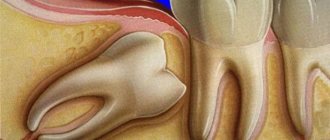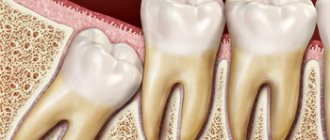Where is a person's wisdom tooth located?
Many people know that this tooth is also called a rudiment, figure eight or 3rd molar.
The name “eight” speaks for itself, since this tooth completes the dentition and is the eighth in a row. There is virtually no benefit to these teeth; they are considered ordinary molars. Formation occurs before the age of 8 and only at the age of 20 do they begin to emerge. The name wisdom teeth was invented back in the old days, because their eruption is equated to the age of maturity in physical and mental terms.
As a rule, the eruption of wisdom teeth is accompanied by pain and discomfort, and in some cases, abnormalities. The latter require surgical intervention.
Symptoms of a wisdom tooth cyst
The peculiarity of the tumor under the “eight” is that the disease is asymptomatic for a long time. The patient does not experience pain or discomfort and is not even aware of his condition. A cyst under a wisdom tooth can be detected on an orthopantomogram or on an x-ray, and this often happens by chance.
However, under the influence of certain factors, for example, ARVI or severe stress, an exacerbation begins. The cyst cavity fills with pus, the following symptoms appear:
- moderate or severe pain when pressure is placed on the gum;
- swelling, swelling of the face;
- swollen lymph nodes;
- increased body temperature;
- general weakness.
Over time, the disease gives complications and can develop into periostitis (flux), osteomyelitis and even sinusitis. There is also a possibility of deformation of the dentition and the development of facial asymmetry.
Reasons for removing wisdom teeth
Oddly enough, 20% of people visiting a dental clinic want to voluntarily get rid of their wisdom teeth, although there is no reason at all for their removal. The answer to the question why they do this is quite simple. It all lies in the fear of future problems.
All other people go to the clinic for real reasons:
1. The wisdom tooth is poorly positioned and does not allow full oral care. This problem must be resolved, since food particles in the teeth can subsequently provoke the appearance of various bacteria, bad breath, tartar buildup and plaque. If pain is felt, treatment will be difficult. 2. Dystopia (crooked wisdom tooth). In this case, you need to be extremely careful, since neighboring ones can be displaced, the roots can be damaged, and the gum tissue can be injured. This phenomenon will lead to inflammatory processes in the soft tissues, as well as pericoronitis, resulting in the formation of an abscess. 3. The tooth does not erupt. Infections develop that lead to the appearance of caries, tartar, and discomfort when clenching the jaws and during chewing. Nearby teeth are damaged.
Symptoms of the disease
The problem does not manifest itself immediately. At first, when food debris has not yet accumulated under the soft tissues, there are no inflammatory symptoms. But later the disease manifests itself with the following symptoms:
- there is an unpleasant odor from the mouth;
- pain occurs in the area of inflammation;
- gums swell and often bleed.
If the wisdom tooth hood is not removed at this stage, the inflammatory reaction will begin to occur very quickly. Then the soft tissues surrounding the “eight” will become bright red, and pus will begin to ooze from the hood. While chewing food, the patient will experience unbearable pain. Due to severe discomfort, he will be forced to limit the mobility of the diseased jaw to the maximum.
The lymph nodes may also become involved in the inflammatory reaction. An increase in body temperature and the appearance of headaches are possible.
When should a wisdom tooth be removed?
In any case, an experienced specialist will ask what is the reason for visiting the clinic and what caused the decision to remove the wisdom tooth. You need to discuss all the sensations with your doctor: the nature of the pain, what sensations are present. The more the specialist knows about the patient’s sensations, the easier it will be for him to carry out surgical procedures.
There are no age restrictions for the procedure for removing the rudiment, so you need to put aside all your fears and go to the dentist. Pay attention to various pains in your mouth and fix the problem as soon as it appears. In this way, unpleasant problems can be prevented.
In what cases is removal justified?
Despite the popularity of such a service as wisdom tooth removal, there are not many real indications for this procedure:
- extensive damage to the tooth by caries (including generalized);
- serious deformation of the tooth or the impossibility of its treatment;
- incorrect position - the extreme molar can grow at an angle or even horizontally, simultaneously putting pressure on neighboring teeth, causing discomfort and pain;
- sometimes the wisdom tooth does not fit in the dental row and grows directly into the gum, causing severe pain;
- nerve damage, inflammation or cyst.
Incorrect position of the extreme molar can provoke changes in the bite and disruption of the dental system. As a result, the patient may develop diseases of the temporomandibular joints and masticatory muscles.
Wisdom teeth do not erupt
You should contact the dentist even if the molar does not cause discomfort. It can remain in this state for up to a certain time, since dental roots grow quickly, and over time they will interfere with the neighbor’s teeth. If a tooth remains in the gum for a long time, then it is a serious provocateur of caries and decay. This arrangement of the rudiment causes injury to soft tissues, resulting in periodontitis, periodontal disease and other unpleasant diseases.
We remove a wisdom tooth that is not growing properly
The rudiment, compared to other teeth, grows later than all others, so there is not enough space for its growth and the arrangement of neighboring teeth changes, they begin to bend.
In any case, a crooked molar can cause injury to soft tissues, which causes blood and wounds on the gums. If pieces of food remain after eating food, there is a risk of infection.
The worst thing is dystopia, since food not only gets into the soft tissues, but also remains in the interdental space. In this case, the teeth are destroyed as the process of decay begins.
When can I do a simple removal?
1. The rudiment has a root system, like other teeth. 2. Most of the tooth is intact. 3. The third molar is not susceptible to caries damage and tartar. 4. Its location is correct and the doctor can easily reach it.
At the clinic, the patient is seated on a dental chair and the oral cavity is examined. An injection produces pain relief. Small incisions are made, and if necessary, the tooth is ground down. Using a special dental instrument, the specialist pries up the root of the third molar and extracts it. Afterwards disinfection is carried out and the bleeding stops. An anesthetic is placed in the place where the tooth grew and anti-inflammatory drugs are prescribed. The patient can return for a re-examination in a week.
Complex wisdom tooth removal
If we talk about complex operations, the leader is the extraction of an impacted tooth that is not able to erupt on its own. Such manipulation is carried out by a highly qualified dental surgeon.
Anesthesia (local) is prepared for the patient. Then the mucous membrane is cut so that it is convenient to get to the roots. In case of a deep tooth location, the doctor cuts out a flap located above the bones. All this also occurs on the mucous membrane, and the cutout resembles the shape of a triangle. Afterwards, holes are made in the jaw to remove the tooth. For such a procedure you will need a drill or ultrasound equipment. Use forceps to remove the figure eight. In case of large sizes, the tooth is removed in parts. An anesthetic is placed in that cavity, which is now empty. And they stitch up the places where the incisions were. Anti-inflammatory drugs are prescribed and are part of complex therapy.
Surgical intervention is also carried out in a similar way when the wisdom tooth is positioned incorrectly. The most complex manipulations include the removal of a tooth where part of the crown has collapsed. Forceps will no longer help here, so specialists use special instruments (surgical, dental). Initially, a flap located in the gum is cut out, after which the part of the figure eight that has been destroyed is removed. Boron is used for this.
If a tooth is cracked, pieces may come loose. In such situations, they are removed from the gums during the intervention. The next month after such an operation, the patient must visit the doctor according to the schedule. The dynamics of recovery will be observed here. And based on this dynamics, individual treatment is selected that is necessary after the operation.
Progress of the operation to remove the tooth hood
When the treatment plan is drawn up, the patient has undergone the necessary preparation, and the operation is performed. It includes the following steps:
Introduction of anesthetic. The painkiller is selected on an individual basis. It is important that the patient is not allergic to it.- Excision of inflamed tissues hanging over the wisdom tooth. To do this, use a scalpel or special surgical scissors. The doctor carefully exposes the entire dental crown so that it can freely erupt to the end.
- Treatment of the resulting wound surface with an antiseptic. Removal of food debris and pus. After this, apply a turunda or compress with a wound-healing solution. It is needed to reduce the likelihood of pathogens entering the wound.
After the operation, the person can go home immediately. But on the appointed day he needs to appear for a second examination. Scheduled visits to a dental surgeon are required until the wound has completely healed.
Is it painful to remove a wisdom tooth?
This is not to say that during such manipulation there will be no sensation of pain. Initially, local anesthesia is administered, but the patient will still feel discomfort and mild pain. Why? The wisdom tooth has a root system that is distinguished by its power. And when it is removed, not very pleasant sensations arise.
Don't use too much painkiller. After the anesthesia wears off, you will feel unwell and in pain. These sensations will continue for several more days. The discomfort will disappear after the stitches heal.
Healing after wisdom tooth removal
After removing the figure eight, blood clots begin to form in the hole. It takes up to two days for them to form. Afterwards, the empty space is filled with granulation tissue, resulting in epithelium. The hole is fully healed after a month.
If infection occurs during surgery, the wound will take longer to heal. If the incisions were sutured using regular threads, then a week after surgery the doctor should remove them. If the removal is careless, this will also delay the healing process. Bone tissue, its formation takes 2-6 months.
Recommendations after wisdom tooth removal
The doctor is obliged to conduct a consultation with the patient and tell him how to behave after the operation. If you follow all the recommendations, healing will be quite fast. Otherwise, the process will be delayed, and unpleasant consequences may occur:
- — after the manipulation, you should not eat or drink for 2 hours;
- - during the next 24 hours after the intervention, you should not eat cold, hot or hard foods;
- - do not rinse vigorously;
- — it is not recommended to warm the cheek on the side where the tooth was removed;
- — visiting the sauna and bathhouse is prohibited, do not take a hot bath;
- - You can’t brush your teeth during the day;
- - try not to take food to the side where the molar was removed, do not chew;
- - It is not recommended to touch a hole that is empty with your tongue, various parts or fingers.
Complications after wisdom tooth removal
In some cases, complications may arise after removing the rudiment. Here the culprit may be the circumstances that have developed, the patient or the medical worker. But in most cases, complications are caused by neglect of advice after the procedure.
Complications:
- - the roots of the teeth that are located nearby are injured;
- - infection develops;
- - gums become swollen;
- - tongue and lips become numb. This occurs due to the fact that the tooth is close to the nerves;
- - dry socket syndrome;
- - alveolitis develops.
There is no longer a need for 3 molars. According to scientists, after 200 years people will not know what the rudiment is. In the meantime, you should monitor your oral cavity and its state of health in more detail. If you suspect a small problem, don't delay. Contact your dentist immediately.
Help measures
Conservative treatment includes:
- rinsing the mouth with antiseptic solutions,
- applications using anti-inflammatory drugs,
- taking analgesics to relieve pain.
If the results of the diagnosis revealed an acute inflammatory process, excision of the hood is performed - a surgical intervention during which the doctor removes the area of mucous membrane hanging over the crown. The operation is performed under local anesthesia. After removing the tissue, the doctor treats the wound with an antiseptic, gives recommendations for further care and sets a date for the next visit to the clinic. Usually, after the procedure, the patient is prescribed rinses with antiseptics, and in some cases, antibiotics.
The patient may also be recommended to have their wisdom teeth removed. This is necessary if:
- the third molar is located at an angle and is strongly inclined to the side,
- There is no room in the jaw for a new tooth.
Based on the results of the x-ray and visual examination of the oral cavity, the dentist will determine whether the wisdom tooth needs to be removed in a particular case.











